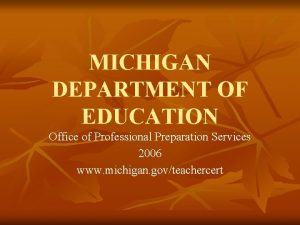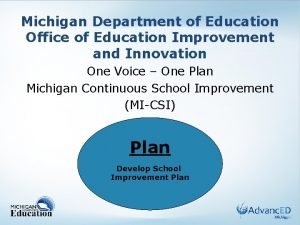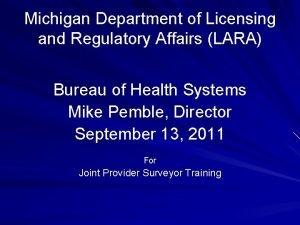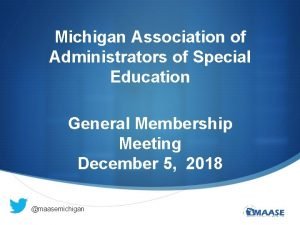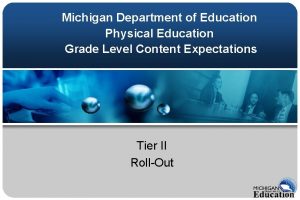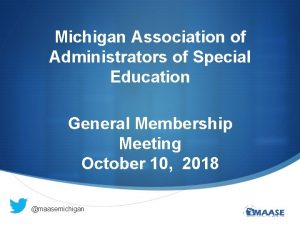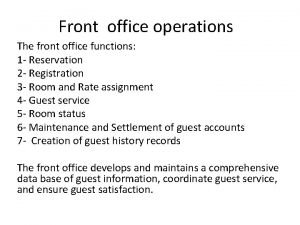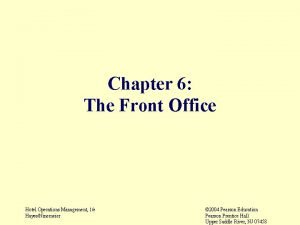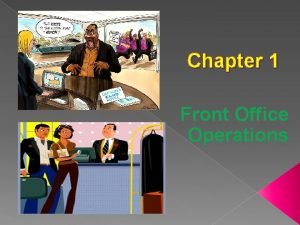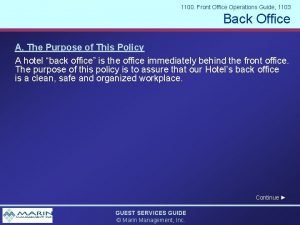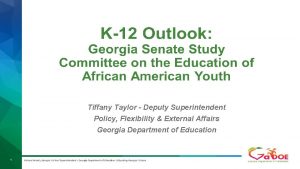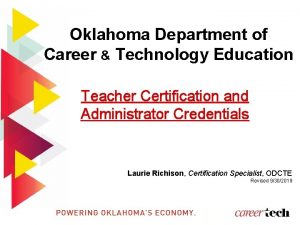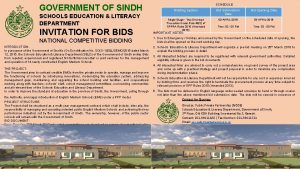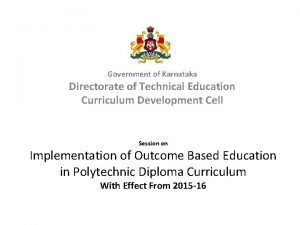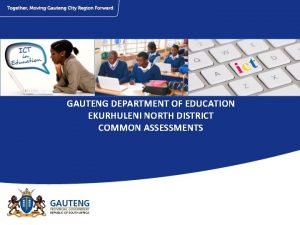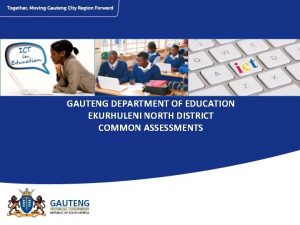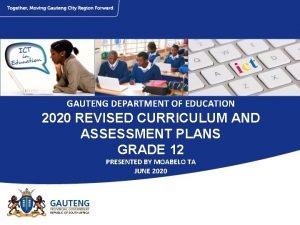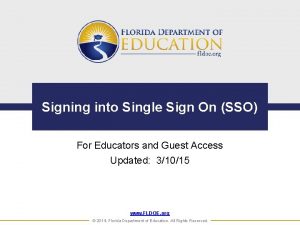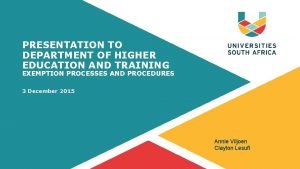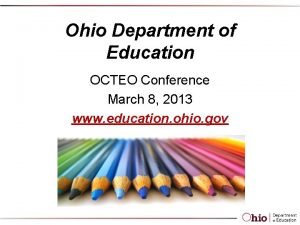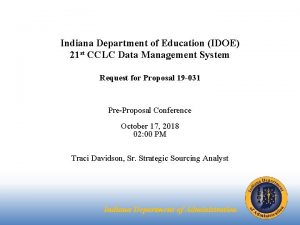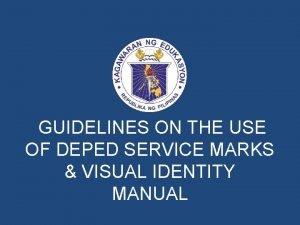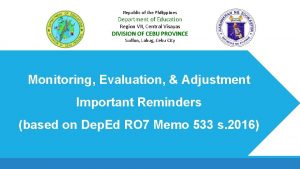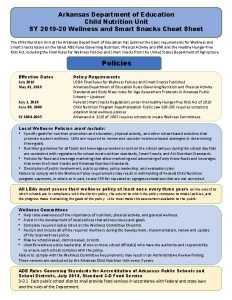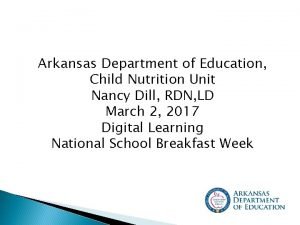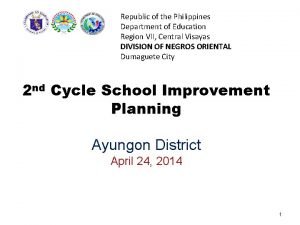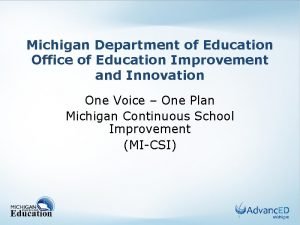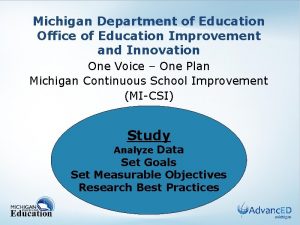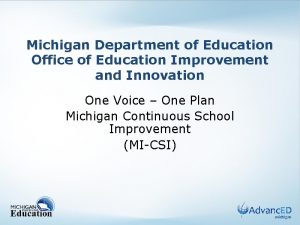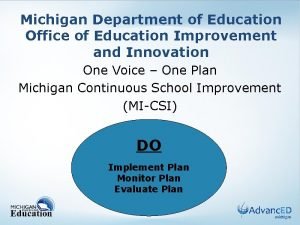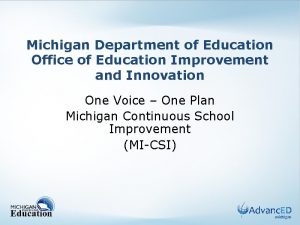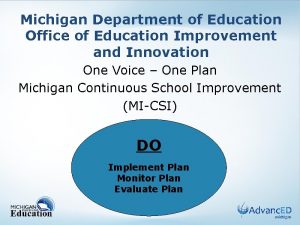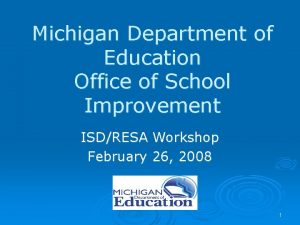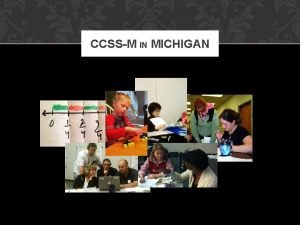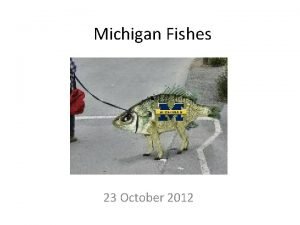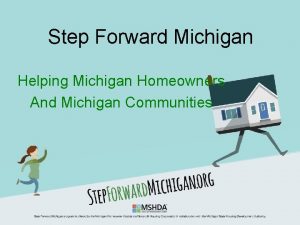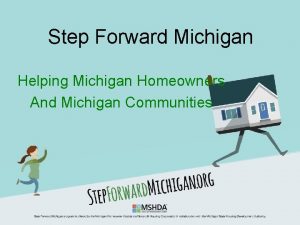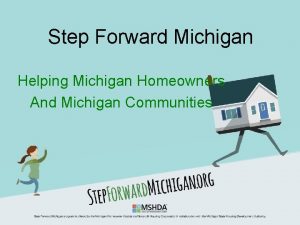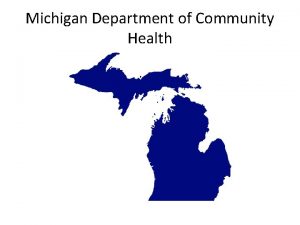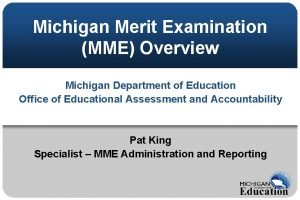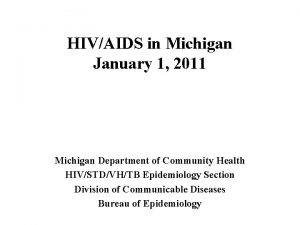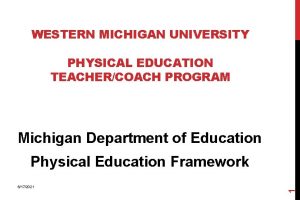Michigan Department of Education Office of Education Improvement


































- Slides: 34

Michigan Department of Education Office of Education Improvement and Innovation One Voice – One Plan Michigan Continuous School Improvement (MI-CSI) Plan Develop School Improvement Plan

Continuous School Improvement Process Gather Get Ready Collect School Data Build School Profile Do Implement Plan Monitor Plan Evaluate Plan Study Student Achievement Plan Develop School Improvement Plan 2 Analyze Data Set Goals Set Measurable Objectives Research Best Practice

Guided Conversations PLAN WHY: Why do we need a School Improvement Plan? HOW: How does the plan reflect the data and data analysis? How does the plan inform job embedded practice to support student achievement? How do we select appropriate strategies and activities to accomplish the goals in the plan? How does the plan address the student needs identified in your data? WHAT: What supports and training are needed to fully implement the plan? What monitoring systems are or will need to be in place? 3

PLAN VOCABULARY Goal Statement SMART Measurable Objective Statement Strategy Statement Activity Statements Components of Effective Implementation 4

Plan Develop School Improvement Plan 5

Continuous School Improvement Process Gather Get Ready Collect Data Build Profile School Data Profile (SDP) School Process Rubrics (SPR) Analyze Data Study Plan Do Comprehensive Needs Assessment School Data Analysis School Process Analysis Set Goals Set Measureable Objectives Research Best Practice School Develop School Improvement Plan Implement Plan Monitor Plan Evaluate Plan 6

Develop School Improvement Plan When you open your SI Plan on the Advanc. ED website, verify that you have been assigned the appropriate SI Plan. 1. SIP (Non Title I) 2. SIP Single Building District (Non Title I) 3. Title I Targeted Assistance 4. Title I Schoolwide 5. Single Building District – Title I Targeted Assistance 6. Single Building District – Title I Schoolwide 7

Advanc. ED website Screenshot of SIP 8

Goals Management Objectives Strategies • Goal Source • Objective Name • Content Area • Measurable Objective Statement • Research Best Practices Goals • Goal Name • Student Goal Statement • Gap Statement • Strategy Name • Strategy Statement • Target Areas Activities • Activity Name • Resource Name • Activity Description • Funding Source • Activity Type • Planned/Actual Staff • Planned/Actual Timeline • Cause for Gap • Measures/ Sources of Data • Criteria for Success • Person Responsible 9 Resources • Planned/Actual Amount

Develop School Improvement Plan Goals Management • Goal Details • Measurable Objective Statement • Strategy Statement • Activities 10

Develop School Improvement Plan Strategy Statement (Adult Actions) • Linked to the measurable objective which is linked to the student goal • Uses specific, planned, research-based and/or evidence-based instructional practices • Addresses system practices that were identified as challenges in the needs assessment • Focuses on maximizing each student’s growth and individual success • Done to, or with, students to develop a specific result 11

Develop School Improvement Plan Criteria for Strategy Statements 1. Begin each statement with “Teachers/Staff will. . . ” (and/or which specific group of teachers and staff). 2. Use an action verb of observable behavior which must be done. 3. Write clear, concise statements that describe what you intend to accomplish. (Be specific. ) 4. Make sure each teacher/staff strategy addresses the issue and connects back to the measurable objective. 12

Develop School Improvement Plan Examples of Strategy Statements • Teachers/staff will use non-linguistic representation, specifically flow maps, to teach critical thinking skills in order to increase student capacity for retelling. • Teachers/staff will implement a common writing rubric based on an identified research-based model (6+1 writing). Specific emphasis will be placed on main idea and details. • Teachers/staff will utilize manipulatives while instructing in standards related to numbers and numeration. • Teachers/staff will incorporate Marzano’s note-taking strategies into science and social studies instruction. Pink = Teachers/staff will Blue = Observable Action Verb Green = Intended Accomplishment 13

REFLECTION QUESTIONS Ø Is this the right strategy to implement? (determined during your research study) Ø Can we implement the strategy the right way? 14

Student Achievement Organization Competency Leadership Components of Effective Implementation Vision Mission Beliefs 15

Leadership Capacity to provide vision/direction of process TECHNICAL ADAPTIVE Does the leadership have the knowledge and skills to effectively monitor and evaluate implementation and impact and to identify known solutions to issues that may arise? Does the leadership have the ability to minimize resistance and to create support for high quality implementation? 16

Competency Staff capacity to support students/parents with the selected strategy/activity SELECTION TRAINING COACHING PERFORMANCE ASSESSMENT Who are the right people to implement the strategy and who will need training? What learning opportunities will support implementation with fidelity? What support will be provided for those who are implementing the strategy/activity? What will be done to monitor fidelity of implementation and the impact on recipients of the strategy/activity? 17

Organization DATA-DRIVEN DECISION MAKING What type of data systems are in place to collect implementation and impact data? What are the decision-making processes and mechanisms to analyze and evaluate data? Organizational capacity to support staff in implementing practices with fidelity LEADERSHIP SUPPORT SYSTEM SUPPORT PERFORMANCE ASSESSMENT How will leadership support successful implementation of the strategy/ activity? What internal systems are in place to support the successful implementation of the strategy/ activity? What processes and mechanisms are in place to evaluate if systems are present and fully functioning to support implementation of the strategy/ activity with fidelity? 18

REFLECTION QUESTIONS Ø Is this the right strategy to implement? (determined during your research study) Ø Can we implement the strategy the right way? 19

Connecting Measurable Objective Statement and Strategy Statement Student Goal Statement: All students will be proficient in reading. Measurable Objective Statement: The percentage of all students proficient on the MEAP in the areas of retelling and informational reading will increase from XX% (Fall, 20 XX) to YY% (Fall, 20 XX). The percentage of non-disabled students proficient will increase from XX%(Fall 20 XX) to YY% (Fall 20 XX), and the percentage of disabled students proficient will increase from XX% (Fall 20 XX) to YY% (Fall 20 XX). Strategy Statement: Teachers/staff will use specific nonlinguistic representation, specifically flow maps, for sequencing to teach critical thinking skills to increase student capacity for retelling. 20

Strategy Statement: Teachers/staff will use specific non-linguistic representation, specifically flow maps, for sequencing to teach critical thinking skills to increase student capacity for retelling. Criteria for Strategy Statement • Begin each statement with “Teachers/Staff will. . . ” (and/or which specific group of teachers and staff). • Use an action verb of observable behavior which must be done. • Write clear, concise statements that describe what you intend to accomplish. (Be specific. ) • Make sure each teacher/staff strategy addresses the issue and connects back to the measurable objective. 21

Give it a try! With a partner, write a strategy for the following measurable objective: Measurable Objective Statement: The percentage of all students proficient on the MEAP in the area of summarizing informational text will increase from XX% (Fall, 20 XX) to YY% (Fall, 20 XX). The percentage of non -disabled students proficient will increase from XX%(Fall 20 XX) to YY% (Fall 20 XX), and the percentage of disabled students proficient will increase from XX% (Fall 20 XX) to YY% (Fall 20 XX). 22

Evaluate Your Strategy Statement • Does your statement include the phrase “All teachers/staff will…”? • Does your statement include an action verb of observable behavior? • Is your statement clear, concise, and describe what you intend to accomplish? • Does your statement connect back to your measureable objective? • Is your statement appropriate for the intended subgroup? 23

Develop School Improvement Plan Goals Management • Goal Details • Measurable Objective Statement • Strategy Statement • Activities 24

Connection to SPR 40/90, SA/ASSIST SA/ES • How will you • address the targeted areas in your comprehensive needs assessment • School Summary Report? Getting Ready to Implement How will you ensure • readiness for implementation? How will you ensure that participants have the knowledge and skills to implement? 25 How will you ensure • successful implementation for your selected activities? • Monitoring Fidelity of Implementation and Impact How will you ensure the program/activity is implemented with fidelity? How will you monitor the program’s impact on student achievement?

Connection to SPR 40/90, SA/ASSIST SA/ES • Getting Ready to Implement How will you • address the targeted areas in your • comprehensive needs assessment School Summary Report? How will you ensure readiness for implementation? How will you ensure that participants have the knowledge and skills to implement? POSSIBILE ACTIVITIES Professional development around strategy for staff and leadership Purchase materials Planning for implementation – Identify schedule for strategy use, personnel, mechanism for monitoring, rollout, etc. Communication vehicles Implement • Monitoring Fidelity of Implementation and Impact How will you ensure • successful implementation for your selected activities? • POSSIBLE ACTIVITIES Communication – to whom? How? Support structures have been identified and put in place Barriers for implementation have been removed, i. e. policy revisions? Process changes? Instructional technology* Activities to support at-risk students (For Title One students)* are delineated • Parent Involvement has been planned *Required Components 26 How will you ensure the program/activity is implemented with fidelity? How will you monitor the program’s impact on student achievement? POSSIBLE ACTIVITIES Walkthroughs PLC/CASL meetings Documentation of implementation is occurring Documentation of impact is occurring Demonstration classrooms Gathering achievement data and process data Schedule for monitoring/evaluating has been developed

Components of an Activity • Activity: Create common lesson plans using manipulatives for math instruction • Staff responsible: All math teachers • Timeline: Fall 20 XX through Spring 20 XX • Human and Financial Resources needed: Time for collaboration for math teachers • Monitoring plan: Math chair/principal will check lesson plans and do walkthroughs every two weeks • Evidence of success: Use of manipulatives reflected in lesson plans and documented in walk-through observations 27

Identifying Activities Considering the components of effective implementation (competency, leadership, and organization), what activities might be needed to “get ready to implement, ” “implement, ” and “monitor implementation and impact” of this strategy? ? Strategy Statement: Teachers/staff will use specific non -linguistic representation, specifically flow maps, for sequencing to teach critical thinking skills to increase student capacity for retelling. 28

Making Connections with the Online School Improvement Template Click the icon below to get to the training and support tutorials for the Michigan School Improvement Template. 29

Continuous School Improvement Process Gather Get Ready Collect School Data Build School Profile Do Implement Plan Monitor Plan Evaluate Plan Study Student Achievement Plan Develop School Improvement Plan 30 Analyze Data Set Goals Set Measurable Objectives Research Best Practice

PLAN VOCABULARY Goal Statement SMART Measurable Objective Statement Strategy Statement Activity Statements Components of Effective Implementation 31

Guided Conversations PLAN WHY: Why do we need a School Improvement Plan? HOW: How does the plan reflect the data and data analysis? How does the plan inform job embedded practice to support student achievement? How do we select appropriate strategies and activities to accomplish the goals in the plan? How does the plan address the student needs identified in your data? WHAT: What supports and training are needed to fully implement the plan? What monitoring systems are or will need to be in place? 32

Questions/Comments? Please contact: Ø Renie Araoz (Araozr@michigan. gov) Ø Diane Fleming (Fleming. D 6@michigan. gov) Ø Diane Joslin-Gould (Joslin-Gouldd@michigan. gov) Or visit the MDE - School Improvement website 33

These training materials and resources were developed in collaboration with the following individuals and organizations. We deeply appreciate their time and support. Renie Araoz – MDE/Advanc. ED Michigan Deb Asano - Marquette-Alger RESA Lisa Bannon - Wexford-Missaukee ISD Ben Boerkoel - Kent ISD Judy Bonne - Wayne RESA Leah Breen - MDE Elizabeth Brophy - Calhoun ISD Betty Burke-Coduti - Marquette-Alger ISD (Retired) Henry Cade - MDE Mark Coscarella - MDE Patti Dobias - MAISA Sharon Dodson - Kalamazoo RESA Deb Dunbar - Bay-Arenac ISD Scott Felkey - Oakland Schools Diane Fleming - MDE Linda Forward - MDE Gayle Greene - Macomb ISD (Retired) Lisa Guzzardo Asaro - Macomb ISD Donna Hamilton - MDE Carrie Haubenstricker - Tuscola ISD 34 Robert Higgins - MDE Fiona Hinds - Advanc. ED Michigan Diane Joslin-Gould - MDE Linda Kent - MDE Scott Koziol - Michigan Center Public Schools Teresita Long - MDE Margaret Madigan - MDE Yvonne Mayfield-MDE Kathleen Miller - Shiawassee RESD Al Monetta - Advanc. ED Michigan (Retired) Cheryl Oczepek - MDE Carolyn Rakotz - Wayne RESA Dodie Raycraft - St Joseph County ISD Karen Ruple – MDE Jennifer Sabsook - Charlevoix-Emmet ISD Kathy Sergeant - Advanc. ED Michigan Consultants Beth Steenwyck Betty Underwood Jan Urban-Lurain
 Michigan department of education teacher certification
Michigan department of education teacher certification School improvement plan michigan
School improvement plan michigan Michigan department of licensing and regulatory affairs
Michigan department of licensing and regulatory affairs Msu physics and astronomy
Msu physics and astronomy Maase jobs
Maase jobs Michigan physical education standards
Michigan physical education standards Michigan association of special education administrators
Michigan association of special education administrators Front office manager organizational chart
Front office manager organizational chart Front desk function
Front desk function Front office department responsibilities
Front office department responsibilities Bucket check in hotel
Bucket check in hotel Semi automated system in front office
Semi automated system in front office Back office department in hotel
Back office department in hotel Va form 10-250
Va form 10-250 Office in factory
Office in factory Tiffany taylor georgia department of education
Tiffany taylor georgia department of education Amy williamson iowa department of education
Amy williamson iowa department of education Oklahoma department of career and technology education
Oklahoma department of career and technology education Sindh education and literacy department
Sindh education and literacy department Directorate of technical education karnataka
Directorate of technical education karnataka Ekurhuleni district of education
Ekurhuleni district of education 10 pillars of gauteng department of education
10 pillars of gauteng department of education Gauteng department of education strategic plan 2020
Gauteng department of education strategic plan 2020 Www.fldoe.org login
Www.fldoe.org login Department of higher education and training
Department of higher education and training Oh.nesinc
Oh.nesinc Prime idoe
Prime idoe D.o. 30 s. 2019
D.o. 30 s. 2019 Department of education region 3
Department of education region 3 Ohio department of higher education
Ohio department of higher education Smea sample program
Smea sample program Arkansas department of education child nutrition unit
Arkansas department of education child nutrition unit Arkansas child nutrition unit
Arkansas child nutrition unit Republic of the philippines department of education
Republic of the philippines department of education Acecqa self assessment tool
Acecqa self assessment tool
